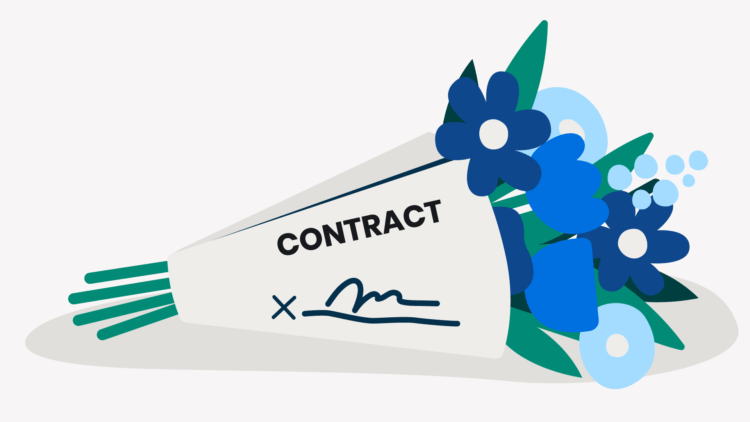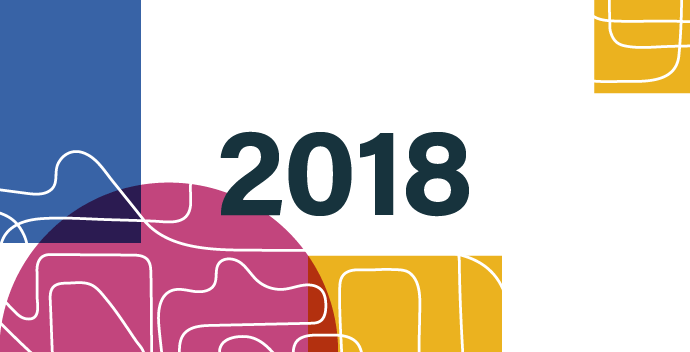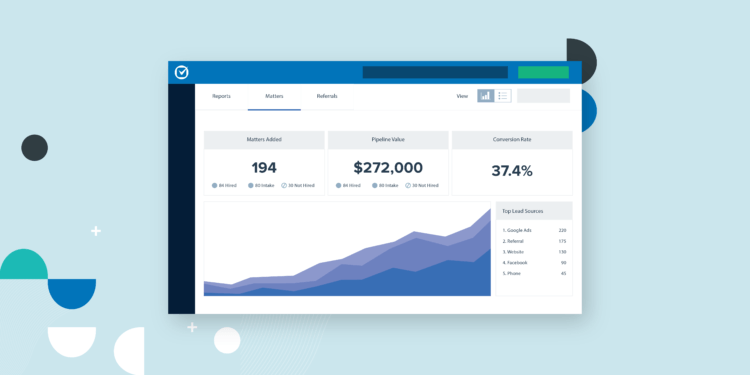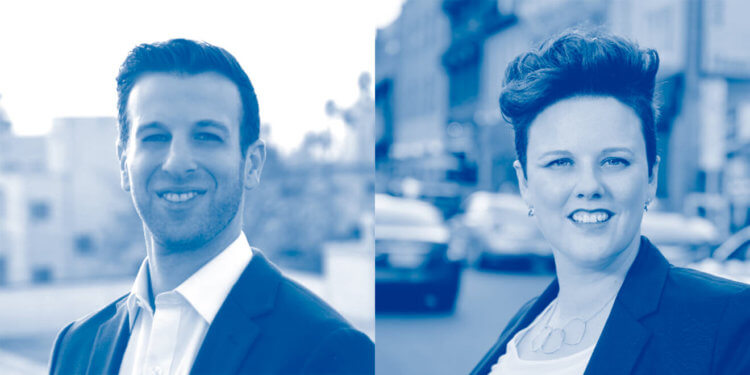
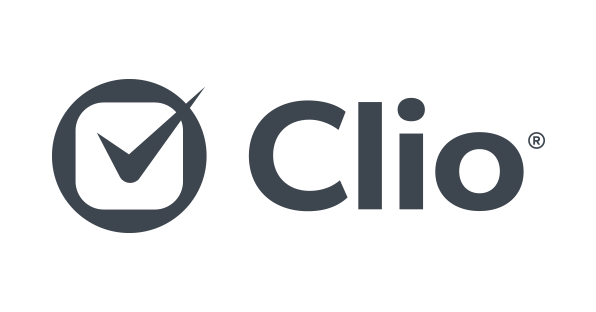
About the episode:
When does a client become a client? Is it when they sign a retainer agreement? Or is it earlier, when they come in for their initial consult or look up your firm’s website?
Client interactions begin earlier than you think. Providing amazing client experiences from the start can lead to happier clients, positive reviews, and more referrals, but legal clients are still frustrated by delayed follow-ups and inconsistent processes.
Michael Chasin, General Manager of Clio Grow, and Jennifer Reynolds, Owner of Fresh Legal, explain the ins and outs of client intake and acquisition—and why paying close attention to the client intake process is critical for building trust with clients.
Jennifer shares some of the success that’s resulted from improving client intake at Fresh Legal, and both her and Michael share their tips for testing, evaluating, and improving law firm client intake processes.
Our Guests:

Michael Chasin
Michael Chasin (JD/MBA) is the General Manager of Clio Grow, the legal client relationship management (CRM) and online intake software that empowers lawyers to deliver better client experiences. An experienced legal tech entrepreneur, Michael is also Co-founder of Lexicata, acquired by Clio in 2018.

Jennifer Reynolds
Jennifer Reynolds is the Founder and Owner of Fresh Legal, a firm focused on family law in Ottawa, Canada. She founded Fresh Legal in 2015 with a desire to change how clients experience separation and divorce, and her goal is to empower each client throughout the process by listening to their story and educating them about their rights and obligations.

Erika Holmes
Erika Holmes is the Founder of ELHolmes Legal Solutions, a family law firm that provides affordable services to clients in Denver, Colorado. She’s passionate about modern representation, an approach where lawyers use innovative processes and technologies to close the access to justice gap and build sustainable, successful practices at the same time.
Host bios:

Teresa Matich
Teresa Matich is the Content Strategist at Clio, where she’s responsible for educating the legal industry on market trends, best practices, and important issues impacting law firms. In her spare time, she enjoys traveling, snowboarding, and traveling to snowboard. Email her at [email protected] or tweet her at @TeresaMatich.

Andrew Booth
Andrew Booth works within the Business Operations department at Clio as the Learning Media Specialist. He is best known as the voice (and sometimes face) of Clio’s training videos, and the voice and tweets behind the @JackNewtonsShoe Twitter account. Andrew received his Broadcast Communications degree from BCIT, and has produced work for such broadcasting outlets as Global News and Roundhouse Radio. Email him at [email protected] or tweet him at @JackNewtonsShoe.

Derek Bolen
Derek Bolen is the Senior Manager of Customer Marketing at Clio, which means he gets paid to build relationships with the greatest customers in the world. When he isn’t working, he’s tweeting, reading, writing, podcasting, running, obsessing over fantasy football, or hanging out with his 5 year old son. Email him at [email protected], or tweet him at @hurrrdurrr.
Show notes
- Michael talks about lawyers wanting to serve clients
- Introduction
- Michael explains the client acquisition funnel and why it’s important
- Michael talks about the importance of prompt and clear client communication
- Jennifer talks about establishing trust through client intake, and making her firm more efficient Michael explains the different stages of client intake
- Jennifer explains some of the improvements she’s made to client intake at her firm, and gives an overview of her entire client intake process
- Erika talks about the importance of technology for improving client experiences
- Michael and Jennifer share tips for improving client intake
- Conclusion
Transcript
Read full transcript
Michael: We didn’t go to law school so we could scan documents. We didn’t go to law school so we could like ask the same questions over and over again. We went to law school so we can help people resolve their legal issues. And doing backend admin work isn’t going to do that; it just creates more work for yourself.
The technology, I know we’ve been talking about experience the whole time, but there are two ways to speak to it. You either do it because you care, or you do it because you care about yourself. And even if you care about yourself, you should still be building a better experience, not only for you but for your clients throughout the process. And you should do that leveraging technology. You shouldn’t replace yourself with technology, but you should supplement and streamline yourself using technology.
Teresa: I’m Teresa Matich.
Andrew: And I’m Andrew Booth. And this is Matters. Matters is a podcast presented by Clio, the world’s leading cloud-based legal technology provider, where we look at small changes that can make a big impact to your daily life and practice. In this episode we’ll be talking about the client acquisition funnel and why it matters.
When does a client become a client? Is it when they sign the retainer agreement? Or is it earlier, when they come in for their initial consult, or look up your firm’s website?
Teresa: If you listened to Episode 1 of Matters, you’ll know that the client experience is key for the success of your practice. But the client journey for law firms starts earlier than you think. The sooner you start providing amazing client experiences, the better you’ll be set up to work with happier clients, receive positive client reviews, and maybe even get more business referrals.
Michael: Yeah, so essentially the client funnel is really about the journey that a client experiences when they go to, forget a law firm, just any business.
Teresa: That’s Michael Chasin, General Manager of Clio Grow, Clio’s legal client relationship management and online intake software.
Michael: When you first contact Apple, when you first contact Uber or whatever it is, that client experience is really what every step of the journey is from start to finish to the time that you first are introduced to that business, or the business owner or the service, until the time that you’ve concluded service with them.
Teresa: He’s also the founder of Lexicata, acquired by Clio in October of 2018, and he earned his JD from Loyola Law School in 2013. We talked to him about the importance of the client funnel and client intake.
Michael: I mean, to be honest, that’s their entire business. You know, if you’re not thinking about the client journey when you’re running your business, you’re completely ignoring the point. You know, the common phrase is the consumer’s always right and give the consumer what they want, right? And so the consumer what they want is an easy, seamless and positive experience.
When you go to Apple, the first thing, you’re greeted when you walk in. If you notice, Best Buy was one of the first ones to do this, but they’ve done a case study with this where, if you are greeted by someone at Best Buy when you first walk in, you’re likely to spend X percent more money during your visit than if you’re not. So it’s all about creating like a positive experience, and not just saying like ‘Hey, here’s a product. Buy it if you want it’, but ‘Here’s an experience along with the product’. That’s going to be a positive impression whether you buy the product or not.
This is completely scientific, right? It’s not a ‘Oh, maybe if you treat clients better then you’ll have higher revenue.’ It’s a proven fact that if you focus on the client experience and you focus on the journey, your business will be more successful in the process.
Andrew: A topic that’s also been discussed in our first episode was the concept of the client experience, or what might also be defined as the client journey. Well, the client funnel is one part of the overall client journey, and it’s a big part too.
So why is it called the client acquisition funnel?
Teresa: Let’s divide the funnel into different stages of a journey, a journey where someone who has never worked with or heard of your firm converts to a paying client. Prospective clients enter the top of the funnel when they become aware that your firm exists. Maybe they visit your website, fill out a Contact Us form, send an email, or make an initial phone call. This person may then book an initial consultation with your firm, or meet with a lawyer or sign an engagement agreement.
However, not everyone that finds your website will be a fit for your firm. So, fewer and fewer potential clients make it to each stage, creating a narrowing effect that’s led to the business world labelling this process as the client acquisition funnel. No matter your firm size or practice area, there will often be at least one stage within the client acquisition funnel that has a gap or a crack, whether this is due to administrative backlogs or prolonged delays in communication.
Michael: If you’re not following up with someone after you have that initial consultation, you’re basically creating a three-foot-gap in that funnel that people are going to spit out towards and to go someone else, or not hire a lawyer. So the important part of a funnel is not just the mentality of what it looks like, but keeping it airtight and not creating gaps in it that allow people to fall out.
Andrew: Regular communication with your prospective clients is key for creating a predictable client acquisition funnel, and ensuring your firm retains potential clients. But unfortunately—and this is a theme that we are all too familiar with throughout the first few episodes of Matters—many firms are still missing the mark.
Michael: So, the ABA did a study on client intake. If you just Google ABA study on client intake, it’s amazing. They basically mock called about a thousand law firms pretending to be clients, and figured out what the reactions were. Basically, 35% of law firms went to voicemail, right? So, like nobody picked up, right? It took on average, I think they said 42% of firms took three days or more, or never, to reply to a voicemail. So like, absolutely horrific stats.
They were like “How are you running a business?” You know these are businesses that charge thousands, tens of thousands, hundreds of thousands of dollars sometimes, right? Imagine you walked into Apple and said ‘Hey, I want to spend $1,500 right now on a computer, and they’re like ‘We’ll call you back in three days’. You laugh because it’s ridiculous. But that’s how it is.
Teresa: You can learn more about the importance of how long it takes to respond to a client in Episode 2 of Matters, where we cover data literacy. But for now, imagine for a moment that you need to call your cell phone provider, or your bank, or an airline customer service. We’ve all been there before, and we’ve all shared a similar experience.
Michael: I was on hold for 15 minutes, and I don’t know if they’re ever coming back, right? And if they would have just like popped in every five minutes, just said ‘Hey, just so you know, I’m still working on this thing’, I would have been like ‘Okay cool, no problem’. But I’m sitting there so frustrated throughout the whole time, like are they coming back or are they not.
When there’s the unknown and you’re not being communicated to, you build up your own narrative in your mind, and you build up your own frustrations. So controlling that narrative and controlling the communication can really impact not only how they view your services at the end of the day, but how they view your relationship.
And if they feel like you’ve got their back, and they feel like you’re on top of your job in terms of like, you’re going to deliver what you should be delivering, they’re never going to second guess you. And I think that’s a problem that a lot of lawyers deal with and I hear them complain about all the time; ‘Oh, my client keeps calling me over and over again asking me what’s going on’.
It’s like ‘Why do you think they’re calling you what’s going on? It’s because they don’t know.’
Teresa: Communicating better isn’t just about timeliness, though that’s important. It’s about the empathy aspect of client service. Put yourself in your client’s shoes and think about what you’d want in their situation. For example, you could set clear expectations around client communication in an engagement letter, to help your clients feel more informed right from the beginning.
Michael: Just preparing you makes it a little bit easier to deal with, and I think lawyers, and business people in general, not just lawyers but lawyers in particular take for granted that lack of knowledge of not knowing what’s going to happen, and assuming that because they know that the client knows. And so I think there’s a big gap of that in the legal industry.
So, education I think is a big thing that I think lawyers can focus on for their clients, to make sure they know what’s happening and what’s going to happen afterwards. A lot of clients will leave the lawyer’s office after getting their will and be like, ‘So what am I supposed to do with this will? Do I just keep it? Do I store it? Do I like put it online somewhere? Do I have to file it? I have no idea.’
There’s no explanation. There’s just delivery of product. And if you had that explanation, you focus on what are they going through and what are they experiencing, not only will you have more empathy but you’ll create a better experience because you’re putting yourself in their shoes.
Teresa: Jennifer Reynolds, Founder of Fresh Legal, a family law firm in Ottawa, Canada, agrees that setting the right tone is important. We caught up with Jennifer at the Clio Cloud Conference, and for her, good client intake is all about establishing trust with clients from the start.
Jennifer: To us it’s a two-fold I think. One is that it is a good business practice to have a good intake process. But more importantly, it lets us begin establishing trust with our clients from the moment that they begin interacting with our firm. And it’s the beginning of their journey with us.
So we want to put them in a good space. We want them to feel good about interacting with us. We want to feel that they can trust us from the very beginning. And if we have a solid intake, we establish a good relationship from the beginning, we can get into the substance of the client’s problem faster, and it’s more likely that we’re going to convert that client or that potential client into an ongoing matter for the firm.
Andrew: But there’s another important part of Jennifer’s story. Her work on a better client intake process was inspired by frustrating experiences within her law firm when trying to set up client meetings. She discovered that being client-centered and focusing on what’s best for her firm didn’t have to be opposing ideas. In fact, they could drive each other.
Jennifer: On the front of why we set it up that way, the big thing, like I said, is trust, establishing a trusting relationship. But it really was driven at the start from having a problem on our end, and wanting to address the friction of having an easy way to set up client meetings, not having to do a bunch of back and forth.
Like, we were searching for a solution to our problem of scheduling meetings and gathering information and making sure that we’re not missing something key at the outset. And what we ended up with is a system that addresses a client need. So we didn’t start from a client-facing question, but we ended up with a client-facing solution that now drives other conversations in our firm of how we can better serve our clients.
Andrew: Another important part of the client acquisition funnel is understanding how it breaks out into smaller sections. Once you know these, you’ll how to give clients what they need at each stage. In Michael’s opinion, there are three stages within the client acquisition funnel. And the first one, he says, is the most important.
Michael: The first stage is what I call the initial interaction stage. And a lot of people think this is, ‘Oh, the first time I talk to someone’. No, this is what you were referring to earlier is the first time they come to your website, or first time a friend of a friend introduces the concept of you and says, ‘Hey, go talk to Michael. He’s a shark’. Or, ‘Go talk to Michael. He’s a really nice guy.’ That’s that initial interaction, right?
The first time you—let’s use Apple again as an example—the first time you interacted with their brand was not the first time you walked into their store. It was the first time you saw someone using their phone. It was the first time you saw someone using their headphones. It was the first time you saw an advertisement online or on TV. It wasn’t the first time you touched a device or walked into their store.
Same thing with you as a lawyer. The first time they interact with you is the first time someone talks about you, the first they see you online, the first time the phone rings and they… You know it’s not the first time they actually talk to you. So, I think a lot of lawyers make the mistake of saying ‘Okay, I only have to focus on the time that I’m going through a consult with them.’ That’s not the stage. So the initial interaction stage is the first part of the funnel.
And that’s arguably the most important thing, right? A lot of people tend not to think about businesses the way they think about relationships where they say first impressions last forever. It’s no different for a business than it is with a person, right? Are you going to be rude the first time you meet them and then all of a sudden be nice and expect them to like you? No. They’re obviously going to be like ‘That person was mean to me the first time, so I think they’re just a mean person’. It might take years for you to recover and kind of recalibrate or rebrand yourself. So first stage of the funnel is the initial interaction stage.
Andrew: After the initial interaction stage, you’ll then move into collecting information about this prospective client.
Michael: The second stage is what I call the information collection stage. This is going to be where it goes from that first interaction to ‘Now I’m just gathering information about your business needs’, right? This is where you’re doing the consults. This is where you’re doing the phone calls. This is where you’re really understanding the needs of them as your customer, right?
And that part is important to still create like a good customer experience, rather than asking them to fill out paper forms or download PDFs or come into the office. You can do screen shares. You can do Google Hangouts. You can do Face Time. There’s tons of different ways that you can make their life easier, instead of [thinking] the initial interaction stage.
So I think customer service is more important in the first step of the journey that it is the second, but obviously it’s still important in both. But if you’re going to place your customer service shops or your resources, I’d put them in that first step because first impressions last forever, and it’s going to set the tone for the rest of your relationship.
Andrew: The third and final stage of the funnel is the retention phase. This stage encompasses everything from the information collection stage up until they’re ready to pay and sign on as a client.
Michael: If someone comes in, does a consult, ‘Okay, let me think it over for a week and I’ll get back to you’, what are you doing in that week? Are you communicating with them? Are you just expecting them to come back to you? Are you basically telling them ‘Hey, I’m hot stuff and if you want to work with me you’ve got to come back to me. I’m not going to…’ You know a lot of lawyers are like ‘I’m not sales people. I’m not going to chase people down.’
You’re like ‘Okay, well you’re never going to succeed as a business if you’re not willing to at least like do some outreach’, right? Plenty of people just forget to do it. And if you look at the Legal Trends Report, there were some interesting figures in there about basically like, you know, they expect to be followed up with. Like clients are getting a different experience than the lawyers are delivering.
Teresa: Those figures that Michael is referring to, from the 2018 Legal Trends Report, relate to the mismatch between how clients expect to be communicated to versus what lawyers think their clients want. For example, 55% of consumers want to learn about the legal aspects of a case in person, while only 2% of lawyers think that’s their preference. Also, 40% of consumers would never hire a lawyer that didn’t accept debit or credit cards.
Michael: So the third step is the retention phase and how you do it. Do you ask them to pay with cheque? 24% of firms are still taking cheque as payment. 24%. It’s like the taxi/Uber thing in Vancouver, right? There’s a lot of people still living in the old times.
And some people want to pay with cheque; fine, let them. But you shouldn’t make someone pay with a cheque. Don’t make the clients do something they don’t want to do just it makes you as a business owner, their life easier. You say ‘What’s the lowest friction or lowest barrier to entry for the consumer? And how do I work around that to create a better experience for my backend?’ not the other way around. How do I create a better experience for my backend? Do the front end.
If you set the expectations and you set your authority and they think you know what you’re doing, they will never second guess you. And that’s one of the biggest complaints I hear from lawyers is ‘The clients are second guessing me and saying I should do it this way versus that way’ or ‘Why am I not hearing from you?’ Well, it’s because you didn’t set the tone right in the relationship.
Andrew: Jennifer gave us a few examples of what that looks like. She made it easier to schedule appointments for both the lawyers and their clients, and thought of a business tactic that solves for a common anxiety point with her clients while still making her firm profitable.
Jennifer: One of the big things that we’ve put into practice is using online scheduling software. So in particular, we use Acuity, and there’s a whole bunch of other tools out there that people like to use. And a lot of our clients comment on how they really enjoyed how easy it was to go online and find a time that worked for them. So it begins creating that frictionless experience right from the start.
We also use automated reminders and automated follow-up emails that are also complemented by personal touches from the lawyer after you’ve met with them. And another big piece for us is we use a flat rate initial consultation. So at the beginning of my practice, when people called and they wanted to come in for a consultation, I’d say “Well this is my hourly rate. It’s going to be charged at my hourly rate and you pay at the time of the meeting.”
And inevitably, around the 45-minute mark they started to look at their watch and things started to rush. And they wanted to get everything in, but they also were very conscious of the amount of time that they were spending there. And so there wasn’t the relaxation that they needed to have, and we didn’t have time to just talk about who they were as people and to start connecting from the very start of the meeting and from the start of the experience.
So we’ve set a flat rate for all of our clients, and we say “Usually the meetings are an hour to an hour and a half long, but it’s a flat rate.” And then we don’t see them looking at their watch, and they don’t feel under pressure, and we can start to establish a really good relationship from that first meeting.
Teresa: To give an even more pointed example of what this level of thoughtfulness looks like, here’s Fresh Legal’s client intake process in full.
Jennifer: The initial contact is done either through an email, maybe through our website Contact Form, or we also offer an option that somebody can schedule a phone call. Right on our website we have our Acuity embedded, so a potential client can go online and pick a time to call a lawyer, and then they know the lawyer is going to be there and going to pick up, and they get rid of that phone tag portion [of the experience].
And it also lets us gather a little bit of information from them right from the beginning. What city do you live in? What’s your former spouse’s name? What are the basic issues that we’re dealing with? So we can make sure from the beginning it’s somebody we can help.
And maybe, if we can’t, we might email them back and say ‘Oh, we notice you’ve scheduled an appointment to speak to somebody tomorrow, but we see that you actually live in Gatineau’, which is across the river, which is an entirely different province and we can’t help them. ‘So we can’t actually assist you, but we do have some connections who might be able to. Here are a few lawyers that we know.’ So it lets us filter people from the start.
Once we have an initial conversation with a person and confirm that we’re able to help, they schedule an initial client meeting, that flat rate consultation meeting, using again the online scheduling tool. They receive an automated email telling them that the meeting’s been scheduled, and to please fill out an intake form, and also, ‘Here are some things you might want to start thinking about before you come in. It would help you have a more productive meeting if you put together a list of your assets and debts, if you put together a timeline, if you took some time to write down some questions that you wanted to make sure. We know this is a stressful time and we want to help you as much as possible.’
After that form is filled out, it gets sent to our Clio right away. And it also gets emailed to the lawyer. So we’re beginning at that point to gather basic information, what their name is, what their kids’ names are, when their birthdays are, their date of separation, the little facts that are really key and important that we don’t want to spend time gathering in our first meeting.
And we also ask them “What are your goals for this first meeting? What’s really important to you to make sure you chat about with your lawyer? What are your pressing questions? What are your goals for your separation?” So we begin to have a concept of how they want to approach the problem and an idea of what’s important to them and what their questions are.
So in that first meeting we can say ‘Oh, you filled out your intake form and I see that you wanted to chat about this issue, and we haven’t had a chance to get to that yet. Why don’t we talk about that?’
Teresa: Jennifer then gives her clients any additional take-home materials at the first meeting that are relevant to their issues. And then, at that point a series of automatic follow-ups are sent to keep the client informed and to provide an additional level of comfort. For Jennifer, the results of this process are clear.
Jennifer: I’d say a lot of our clients are happier. Things are more seamless. They’re feeling better served. They know that they can schedule a meeting with us. You know, if they’re awake at two o’clock in the morning worrying, they can go to our website, schedule a phone call, and know that they’re going to reach us, right? They know that their lawyer’s going to have the information that they need.
And then simple things like we’re not missing key information. We’re not getting three months into a retainer and realizing that we forgot to get the kids’ birthdays, because it’s already gathered. And we know it’s accurate because the client is the one who typed it into. We’re not transcribing and we’re not trying to read handwriting. We’re not layering steps in to get the information into Clio where it’s at our fingertips. We’re having the client input accurate information, and it’s getting put into our system, and that let’s serve our clients better. And I think our clients know that they feel safe, and it lets our lawyers know who our clients are.
Andrew: One key theme of Jennifer’s experience with client intake is that she didn’t improve her process alone. She’s made things easier for her staff and clients with the help of technology. And she’s not the only lawyer who’s done so. For example, there’s also Erika Holmes, Founder of ELHolmes Legal Solutions, a family law firm in Colorado. She’s been using Clio Grow, Clio’s new client relationship management and online intake software, to help streamline her client intake, which has made a big difference in terms of how Erika looks at her process.
Erika: I guess one of my expected benefits is it really made me start to do, I guess it’s called process mapping, because now I’ve got to set up the system to make sure that it’s doing all the things that I’m doing that I can’t even remember that I’m doing. And so it’s really made me like think through everything.
And so, as an example, when I’ve got—I do my initial client contact and then there’s a certain amount of follow up that I have been doing before I had Clio Grow. And as I’m going through this process of mapping, I’m like ‘Oh, you know what? I could throw in an automated email to do a follow up on this’, which isn’t normally my style. Because the way that I deal with clients is that they have to put some effort into it as a potential client, because that shows me what kind of client they’re going to be in the future.
And so when I have contact with a client, there’s a certain amount of follow up that I do, and then actually I cut myself off in terms of like they need to then start doing some follow up. But I found some holes in there where I’m just like ‘Oh okay, well this wouldn’t cost me anything’ or doing kind of, so that one other email here or that.
Teresa: For Erika, the client experience is huge. 92% of her clients come from referrals, and she’s a strong advocate of using technology to improve the client experience from end to end.
Erika: I think it’s huge. I would say like 80% of the client experience is going to be probably be involved with technology, because it’s what’s making it easy and seamless for them, from them being able to access their information, for attorneys to be able to communicate back with them. You know I’m a single practitioner, and I would love to be available to my clients all the time but, you know, I have a life too.
So being able to say ‘You can do this’ or even like if I want to write emails on a Saturday but I don’t want my, necessarily my clients to be responding to me on a Saturday, being able to like time them out to go out on Monday and, you know, use simple things like that.
Andrew: So how can you start tweaking and improving client acquisition at your own firm? Both Michael and Jennifer had a few tips. First, it’s important to get some information about how your process feels. Michael suggests a peer-review approach.
Michael: So I think the first thing that you should is have a friend or a family member stress test your firm, right? Like, you should have a couple people. Like, I would do that. When we created like an automated email sequence for Lexicata, who was the first the person that went into that funnel? Michael, right? Not anyone else. I didn’t test on my clients. I tested on myself.
So I think what you can do is you can say, like ‘Okay, call. Here are the facts that I want you to fake. And I want you to talk and tell me how my receptionist was.’
We had a firm who was using like an email automation tool. They used to calls, like I think they said on average they were getting about 18 calls a week from clients just calling in to check in what’s going on. Because oftentimes, in litigation, or even transactional, you can go months without talking to your lawyer and like, ‘What the hell is going on? I don’t understand. I’m worried.’ Right?
And it’s par for the course for the lawyer. They know what’s going on, but the client has no idea, right? So one thing you can do early is set expectations. Maybe you send them a one-page PDF that just says, like ‘Here’s an average timeline of litigation’, right? Just so they know what they’re expecting. So you can set expectations. And what does that do? It makes them less angry because [they’re not thinking], ‘Why haven’t I heard from you for two months?’
And then the other thing is making your life easier too. So that same lawyer who was like ‘I’m getting 18 calls a week. This is a waste of time. I can’t bill for this. It’s creating a bad experience.’
So what he did is, he basically set up email automation to go out like every week or two, just to keep them informed; ‘Hey, just so you know, this is what stage of the system we’re at’ or ‘of the litigation we’re at’. ‘Hey, here’s some stuff you can read about how the process works’, and things like just keeping them engaged and communicated with. And what happened? He told me he took the average number of like unsolicited calls from his clients from 18 a week down to two.
Andrew: For Jennifer, the important thing is to just getting started. Even small changes can have a big impact on the intake experience for your clients.
Jennifer: We’ve improved our forms over time, [so] get out there and start building something, and try not to be overwhelmed. Like, start with ‘We’re going to implement online appointment scheduling.’ Just do one thing. Or, ‘We’re going to have online intake forms.’ Don’t expect to have a fully fleshed-out system from the beginning. And the philosophical sort of number-one tip is use this as an opportunity to establish that trusting relationship, and don’t underestimate the value of client intake.
Andrew: Finally, while it’s crucial to put process first when streamlining your client acquisition funnel, it’s also important to invest in technologies that can help make the process easier. As Michael explains, an investment in technology for your business can mean a big improvement for your firm’s bottom line over time.
Michael: Yeah, the role of technology is 95% of it, right? So, I told you earlier, if you surveyed all law firms and asked, like ‘Do you think creating a good client experience would create more work for you or less work for you?’, most of them would say it would create more work for you.
And I agree up front. It takes some investment, just like anything. You want to buy a software that allows you to automate data entry, right? You don’t have to use paper intake forms anymore. But it’s going to take you an hour to set up those forms, right, an hour more than it would have just to send out that PDF that you’ve been doing the whole time. So it takes investment in yourself in order to get there. But technology will allow you to have that result of creating a better experience without creating more time for yourself.
So again, when I was talking about that story earlier about how that person was getting about 16 or 17 calls a week, and then all they did was set up like a four-email automated journey that probably took them about 15 minutes, and that saved them 15 calls a week and about three hours a week. You extrapolate that over a year, 150 hours a year, that’s like four work weeks a year of avoiding calls and still creating a better experience.
But he had to, one, set up those four emails and think through them. Two, he had to research the software that would allow him to do it. Three, find those softwares and demo those softwares, right? So it probably took him five or 10 hours to go through that process of finding that tool, in order to save 150 hours over the course of that year, right? You have to want to invest. And a lot of lawyers, because they are a commodity, right, there are a finite number of hours they can bill in a year, they tend to have the mentality that ‘Every hour I’m not billing is an hour I’m not losing money’.
Teresa: Offering e-signatures, customizing online intake forms and integrated different systems at your firm can help save you hundreds of hours per year in tedious tasks, and save your clients some of the pain and paperwork. But the most important part is, building a better client intake process won’t just make things easier for your clients and better for your business. You’ll be more empowered to do great work, and you’ll improve your quality of life as well. That’s an investment worth making.
Michael: The world’s just a better place if we care about what each other go through, right? That sounds like a very emotional response to like a business question, but really that’s the truth. If you create a better experience for your clients, they’ll create a better experience for you working with them.
Lawyers have a really tough life, right? They’re constantly under stress. They’re constantly being barraged by tough questions. They’re constantly under deadlines, depending on what type of practice you are. It’s a very high-stress life. Something as simple as really focusing on like creating a better experience for other people will end up creating a better experience for you. You look at the happiest people on the planet, they’re the people who give to charity and volunteer all the time. They’re not the people who are focused on their life.
Jennifer: At the end of the day, we’re running a business. And to run a successful business you need to do good work. And underlying doing good work as a lawyer, especially in our field and I think in all fields, is having a good relationship with that client and providing really good client service. And so if I have a good client experience, I’m doing those things. And if I provide my clients with tools to make their experience easier and better, I’m making it easier for them to help me do a good job. So it’s a circular, you know, self-feeding circle.
Teresa: You don’t get a second chance at a first impression. We know from the Legal Trends Report that 62% of consumers ask friends and family for recommendations when they’re looking to hire a lawyer. So, creating a positive initial interaction and providing a great experience throughout the entire client journey is critical for securing new clients.
Andrew: To improve your client intake process, start by putting yourself in your clients’ shoes. What would you want? Then, stress test your current client intake process, ask your staff for ideas, and start implementing small improvements. Turn to tech and the efficiency of your client intake process could really start to take off.
You can get more tips on client intake and more stats on how lawyers communicate via the links in the resources section of this podcast.
Teresa: Thanks for listening to the third episode of Matters. Matters is produced by Andrew Booth, Teresa Matich, and Derek Bolen, and by Clio, the world’s leading cloud-based legal technology provider. Be sure to subscribe to Matters to ensure you never miss an episode. If you’d like to learn more about Clio, please visit us at clio.com.
